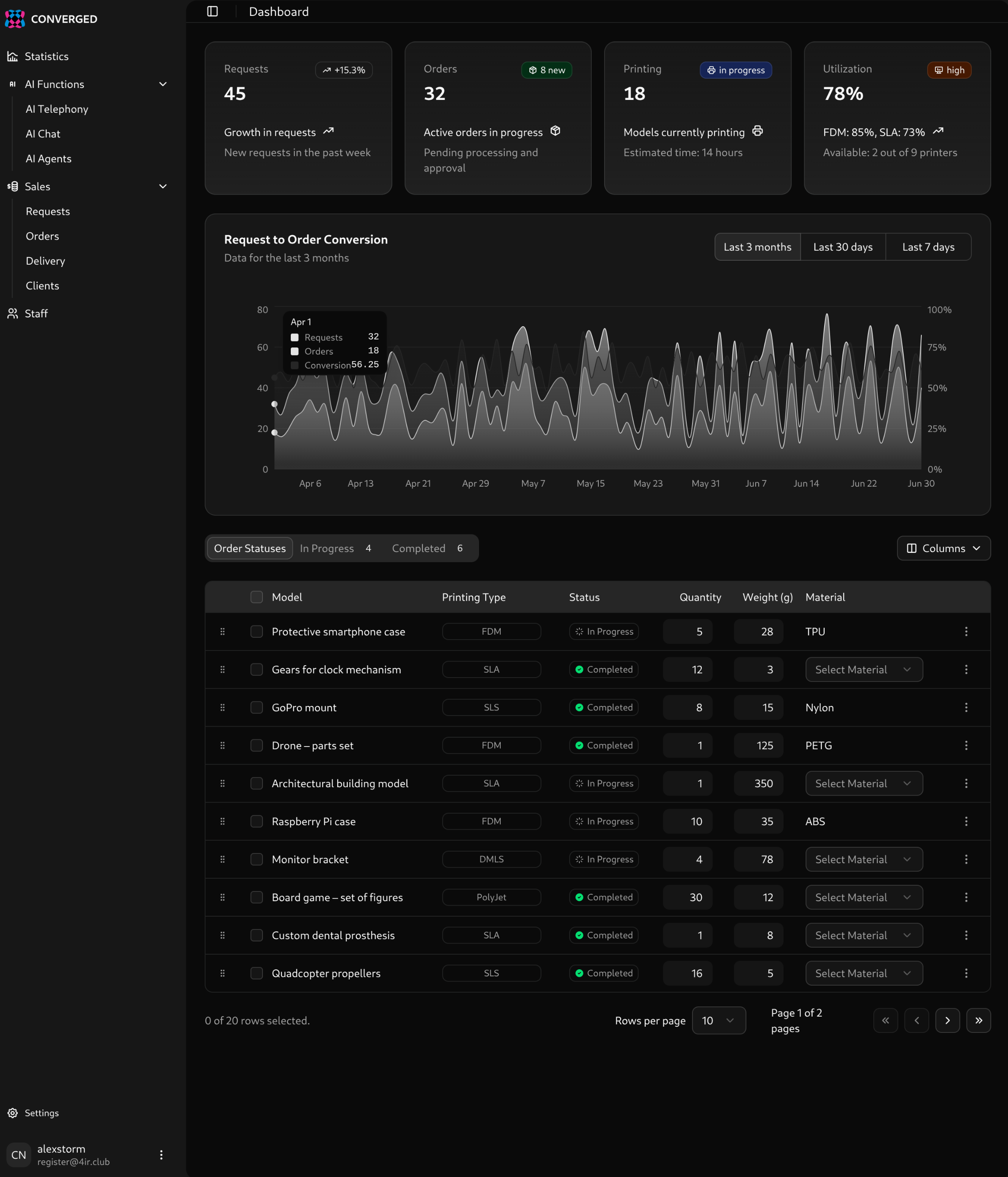Converged Platform


All data is stored in a secure environment using:
Each club member retains full control over their data by hosting it in their own cloud, managing access rights, and ensuring the protection of confidential information.
Our AI systems operate 24/7 to receive and process orders using integration with leading AI platforms:
Additionally, predictive analytics technology monitors equipment status and forecasts potential failures. This allows for proactive maintenance planning, avoiding downtime, and efficiently utilizing resources.
The integrated management system covers all key aspects of production:
Additionally, built-in analytical tools allow for calculating key performance indicators, identifying potential constraints, and forecasting results, ensuring continuous improvement of all production processes.
Modules based on ESP32 are used to collect logs and key performance indicators of production equipment. The collected data is transmitted to a central platform where in-depth real-time analysis occurs.
The system provides:
Below is the correct version with working tables:
| Interface | Equipment | How to Connect | Coverage |
|---|---|---|---|
| RS-232 (DNC) | Old CNC (Fanuc, Siemens 10–20 years, etc.) | ESP32 + MAX3232, port-parameter setup | 60–70% |
| UART (TTL) | Grbl (mini-mills), Marlin/Repetier (3D printers) | Direct TX/RX connection | 70–80% |
| Ethernet | Ruida (lasers), MTConnect, OPC-UA (industrial machines) | LAN cable, network configuration | ~50% |
Below are average estimates of costs and efforts per machine (or one device), considering the need to purchase inexpensive components and perform basic interface setup.
| Equipment | Setup Complexity | Approximate Cost* |
|---|---|---|
| Old CNC (RS-232) | - Connect MAX3232 to ESP32 - Set up DNC/baudrate/XON-XOFF - Check DB25/DB9 pinout | ~30–50 USD |
| Modern Chinese | - For UART (Grbl), a pair of TX/RX is sufficient - For Ethernet (Ruida), protocol knowledge is needed - Sometimes non-standard connectors | ~20–40 USD |
| Open 3D Printers | - Most FDM printers (Marlin, Repetier) have an open port - Minimal firmware setup required | ~10–30 USD |
| Closed/Specific | - No standard ports or proprietary protocol - Additional sensors or complex reverse engineering required | >50 USD |
*Includes approximate price of ESP32 (5–10 USD), adapters (MAX3232, Ethernet cable), and basic installation work.
Open Systems (Grbl, Marlin, Repetier, LinuxCNC):
Easy to obtain logs and statuses through a standard text protocol (G-codes, ok/error responses). Simply solder to TX/RX or connect to USB-Serial.
Classic CNC (Fanuc, Siemens, Haas):
Usually have RS-232. The machine can provide basic statuses (program completion, error) and send/receive G-codes.
Modern Chinese Machines (Ruida, Trocen, DSP Controllers):
Closed/Specific Solutions:
If the controller has no available port, separate sensors can be installed (spindle operation monitoring, vibration sensors, current consumption) or “sniffing” on the internal control bus can be implemented.
Thus, the log collection module is a universal tool for “digitizing” machines and 3D printers. It simplifies monitoring and analysis of production processes, helping operators and managers effectively manage equipment and respond to potential problems in real-time.
How the cloud is structured
How data is stored
